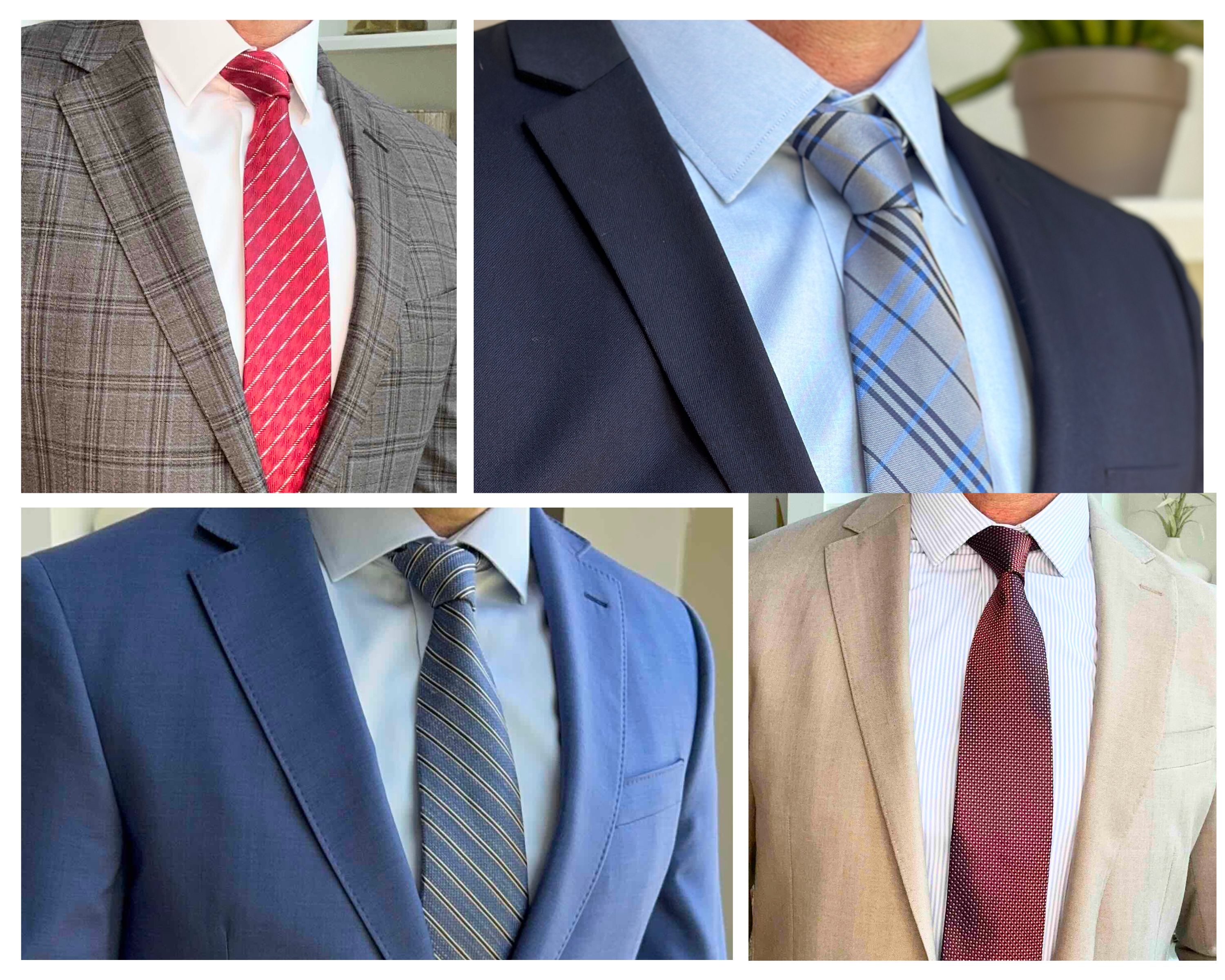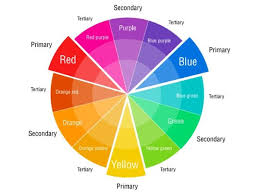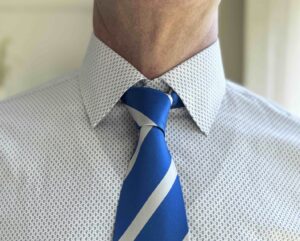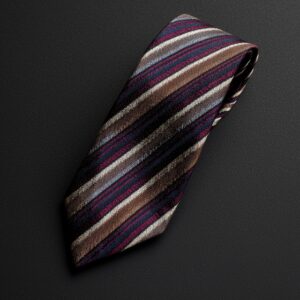
Matching ties with shirts and suits can significantly enhance your wardrobe and confidence. It all starts with understanding the fundamentals of color theory. Complementary colors sit opposite each other on the color wheel, creating a visually pleasing contrast. When selecting a tie, consider how its color and pattern will interact with your shirt and suit.

For example, a light blue shirt is an excellent backdrop for a patterned tie. My favorite is a patterned burgundy tie with a white or blue dress shirt. The subtlety of the light blue allows the tie to stand out without overwhelming your outfit. Similarly, a classic white shirt offers a neutral canvas that pairs well with bold and understated ties, making it a versatile choice for various occasions.
In business settings, you want to project professionalism while allowing for a touch of personal style. A patterned tie can beautifully achieve this balance. Opt for patterns that are refined and not too busy. Stripes, small dots, and subtle geometric patterns are ideal choices. Ensure the colors of the tie complement your suit and shirt, creating a cohesive look.

Brown Plaid Jacket with Red Striped Tie
For more casual settings, you can experiment a bit more. Mixing patterns, such as pairing a patterned tie with a plaid dress shirt or suit. This can be trendy and expressive. Just make sure the patterns don’t match. For example, a striped purple tie with a soft plaid pattern dress shirt can look great. The key is to ensure that the patterns differ in scale. For instance, a large checkered shirt pairs well with a tie featuring smaller, subtle patterns.
Polka dot ties are a versatile option to transition between formal and informal settings. They offer a playful yet sophisticated element to your outfit. When incorporating a polka dot tie, ensure the rest of your attire remains relatively subdued to allow the tie to be the focal point.
Not wearing a tie with your suit today? Read How To Wear and Style a Suit With No Tie.
Select colors evenly spaced around the color wheel when considering a triadic color scheme. This approach creates a balanced and vibrant look. For instance, pairing a yellow tie with a blue suit and a red pocket square can make a striking yet harmonious ensemble.

Yellow and Blue = Triadic Color “Match”
Remember, the texture and fabric of your tie can also significantly influence your overall look. Silk ties are a staple for business settings due to their elegance and smooth texture. In more relaxed environments, you might explore wool or knit ties for a touch of casual sophistication.
Pairing ties with shirts and suits is about matching colors and expressing your style and confidence. Understanding these principles allows you to create refined and expressive outfits suitable for any occasion.

Different Patterns: Dots on Shirt, Stripes on Tie
White and blue shirts are indispensable staples in any man’s wardrobe. The neutrality of a white shirt offers unmatched versatility, providing a perfect canvas for various tie combinations. Whether you prefer bold colors or intricate patterns, a white shirt ensures your tie stands out without clashing with the rest of your outfit. This makes it ideal for formal business settings and more relaxed social events.
On the other hand, a blue shirt, especially in lighter shades, offers a bit more personality while maintaining ease of pairing. Light blue shirts complement a wide range of tie colors and patterns, making them a go-to option for many men. The subtle hue of a light blue shirt serves as a sophisticated backdrop for patterned ties, allowing you to create a balanced and refined look. This color is particularly effective in business settings where you want to project both professionalism and a touch of individuality.
When it comes to tie patterns, a white shirt offers the freedom to experiment. For instance, a white shirt pairs beautifully with a bold, striped tie, adding a dynamic element to your ensemble without overwhelming it. Alternatively, a white shirt with a subtle, geometric-patterned tie can balance understated elegance and modern flair.

Analogous Shades of Blue Create Foundation
Blue shirts also offer remarkable versatility, but in a slightly different way. A light blue shirt can harmonize effortlessly with ties in red, navy, or green shades, allowing for a cohesive yet visually interesting look. Try pairing a light blue shirt with a patterned tie featuring small dots or intricate designs for a more daring combination. The key is ensuring that the patterns do not compete but complement each other, creating a harmonious appearance.
Both white and blue shirts offer room for playful experimentation in more casual settings. For example, mixing a blue shirt with a patterned tie can bring creativity to your outfit. Whether it’s a casual Friday at the office or a weekend brunch, the light blue shirt offers a relaxed yet stylish foundation for your attire.
Whether you’re dressing for a board meeting or a weekend outing, these shirts offer unmatched flexibility and style, making them essential in any man’s wardrobe.
Patterned ties are a fantastic way to inject personality and flair into your wardrobe. A patterned tie paired with a solid suit can convey a perfect mix of professionalism and creativity in business settings. Stick to subtle and refined patterns, such as thin stripes, small geometric shapes, or micro-dots, ensuring they don’t clash with the rest of your outfit.
For casual settings, you can experiment with bolder patterns and combinations. Feel free to mix a patterned tie with a patterned shirt or even a patterned suit, as long as the patterns differ in scale. For example, a small polka dot tie can pair nicely with a large checkered shirt, creating a balanced and stylish look without overwhelming the senses. Finally, a lavender or pink shirt is versatile for most business and casual settings, and is less seasonal than it used to be.
Polka dot ties are versatile and seamlessly transition from formal to casual settings. When wearing one, ensure the rest of your outfit remains relatively subdued to keep the tie as the focal point. This balance will ensure your look is cohesive and not overly busy.
The triadic color scheme can be useful when selecting tie patterns and colors. You can create a balanced yet vibrant appearance by choosing colors evenly spaced around the color wheel. For instance, a tie featuring yellow patterns can be paired with a blue suit and a red pocket square for a striking and harmonious look. 

Analogous Color Pairings – Blue and Light Blues
An analogous color scheme is different. Analogous colors consist of three colors that are side by side on the color wheel. For most, this feels safer, but there is little difference or “contrast” between analogous colors. The most common analogous tie and shirt pairings are blue and blue/green or blue and blue/purple. I recommend jumping across the color wheel for stripes or patterns, like burgundy stripes on a blue tie and a light blue shirt.
Regarding fabric, silk ties are the go-to for business environments due to their elegance and smooth texture. However, exploring different textures, such as wool or knit ties, can add a touch of casual sophistication in more relaxed or casual settings. These materials bring a unique dimension to your outfit, offering a fresh take on traditional tie styles.

Brown shades are great for Fall/Winter
Additionally, incorporating seasonal colors can enhance the appropriateness of your attire. During fall, warm-colored ties like burgundy or deep orange are excellent choices, while cooler shades like light blue or green are more suitable for spring and summer.
Patterned ties allow for a lot of versatility and personal expression. By understanding how to balance patterns, colors, and textures, you can confidently wear patterned ties in various settings, always looking stylish and put-together.

Burgundy Tie With Taupe Suit
Understanding how colors work together is crucial in creating harmonious and stylish tie combinations. The triadic color scheme is particularly effective, offering a balanced yet vibrant look. This scheme involves choosing three colors evenly spaced around the color wheel, such as blue, red, and yellow. For example, you could pair a blue suit with a red tie and a yellow pocket square. This approach ensures that each element of your outfit stands out while still looking cohesive.
Seasonal changes also play a significant role in color selection. Consider ties in warm hues like burgundy, mustard, and deep orange during the fall. These colors complement the season and add a layer of richness to your outfit. Burgundy ties are especially versatile and can be paired with various suit colors, offering a touch of sophistication.
In contrast, spring and summer call for cooler shades. Light blue, green, and pastel tones are excellent for these warmer months. These colors evoke a sense of freshness and are easier to pair with lighter fabrics, often worn during these seasons. A light blue tie, for instance, can be paired effortlessly with a navy suit and a crisp white shirt, creating an elegant and seasonally appropriate look.
Fabric texture is another factor to consider alongside color. Silk ties are generally more suited for formal and business settings, but as the weather warms up, you might want to explore lighter materials like linen or cotton. A cotton tie adds a playful touch to a formal suit or blazer. These fabrics offer a different texture and align better with the seasonal climate.

Spring Analogous Color Scheme
Patterned ties also provide opportunities to play with seasonal colors. In the fall, a tie with subtle checks in warm colors can be paired with a solid shirt to add depth to your outfit. In spring, a floral patterned tie in pastel colors can bring a cheerful element to your ensemble.
Considering the triadic color scheme and seasonal shifts, you can elevate your tie game and ensure that your wardrobe remains stylish and appropriate throughout the year.
Navigating the world of tie and suit color combinations can be both an art and a science, but mastering it will elevate your style game significantly. Let’s start with the gray suit, a versatile staple in many wardrobes. A gray suit pairs well with various tie colors, offering plenty of room for experimentation. Pair a gray suit with a blue tie and a white shirt for a classic look. This combination is timeless and exudes professionalism. To introduce some flair, consider patterned ties. A tie with subtle geometric patterns or even a diagonal stripe can add a touch of sophistication without going overboard.
Navy blue suits are another wardrobe essential, known for their flexibility. The deep hue of a navy suit provides a rich background for numerous tie options. Solid ties in shades like burgundy, gold, and forest green can create a striking contrast while maintaining a professional appearance. For those willing to experiment, a patterned tie can add personality. Think about small polka dots or thin stripes that won’t overwhelm the ensemble but will offer a fresh twist.

Stripe Red Tie with Smaller Stripe Suit
For lighter suits, such as tan or light gray, pastel-colored ties are an excellent choice. These colors add a soft, sophisticated touch to your look. A light blue or pink tie can work wonders, especially in the warmer months. These combinations evoke a sense of freshness and are perfect for less formal business settings or social events.
Let’s not forget the importance of the shirt color. A white dress shirt is a universal match for any tie, allowing you to freely play with colors and patterns. On the other hand, a light blue shirt offers a bit more personality while still being easy to match. It works particularly well with ties in red, navy, and even green shades.
Ultimately, the key to successfully pairing ties with suits is understanding the balance between colors, patterns, and textures. Whether you stick with solid colors for a polished look or introduce subtle patterns for added interest, the right tie can significantly impact your overall style.
Pocket squares add a touch of elegance to any suit and tie combination, but it’s essential to choose them wisely. Instead of matching your pocket square exactly to your tie, aim for a complementary approach. This creates visual interest and sophistication without looking overly coordinated. For example, wearing a navy tie with a light blue shirt, a pocket square with hints of blue and white, or even a subtle pattern incorporating these colors, it can complete the look beautifully.
For many reasons, silk remains the gold standard for tie fabrics. Silk offers a range of options, from lustrous and smooth materials to raw silk and shantung renditions. In business settings, a silk tie can convey a sense of elegance and professionalism. Its smooth texture and slight sheen make it a versatile choice that pairs well with both solid and patterned shirts. In more casual or social settings, consider experimenting with different textures. A knit tie or one made from wool can add a relaxed yet stylish touch to your outfit. These materials bring a unique dimension, offering a break from the traditional silk while still maintaining a polished appearance.
Consider the season and setting when choosing colors and patterns. For fall and winter, wool ties in darker, richer colors can add depth to your outfit. In contrast, lighter fabrics like linen and cotton are excellent choices for spring and summer. These materials offer a different texture and align better with the seasonal climate, providing comfort without sacrificing style.

Fall/Winter Tie Style
Pairing your tie with the right pocket square and understanding the nuances of different fabrics can elevate your overall look. Whether in a business meeting or attending a social event, the combination of a thoughtfully chosen tie and pocket square can make a significant impact. So next time you’re putting together an outfit, don’t overlook these small yet powerful details.
Checked shirts can be a fantastic addition to your wardrobe, offering a blend of casual charm and sophisticated style. The key to pairing ties with checked shirts is to focus on balance and contrast. When you wear a checked shirt, opt for a tie that either picks up one of the colors in the shirt or provides a solid contrast. For example, if your checked shirt has hints of blue, a navy tie can create a cohesive and polished look.
Solid ties are generally the safest bet when dealing with checked patterns, as they prevent your outfit from becoming visually overwhelming. However, don’t avoid experimenting with patterns; make sure they differ in scale. A tie with a small, subtle pattern can work well with a shirt featuring larger checks, creating a balanced and stylish appearance.
Sticking to a monochromatic color scheme for formal settings, especially when wearing a black suit, can convey elegance and refinement. Solid color ties or those with subtle patterns, such as pin dots or fine stripes, are excellent choices for these occasions. They maintain a sleek and polished look, ensuring your outfit remains sophisticated without being overly flashy.
When selecting a tie for a black suit, consider the timeless appeal of a solid black or dark gray tie. These options blend seamlessly with your suit, creating a unified and professional look. For a touch of subtle flair, a tie with a very fine pattern can add depth without compromising formality.
Remember, the texture of your tie can also enhance your overall ensemble. Silk ties are ideal for formal settings due to their smooth texture and slight sheen, which add a touch of elegance to your outfit. If you’re aiming for variety, consider a tie with a slight texture, like a fine rib or a delicate weave, to add interest without drawing too much attention.
By thoughtfully pairing your ties with checked shirts and considering the formality of your setting, you can create a balanced and stylish look suitable for any occasion.